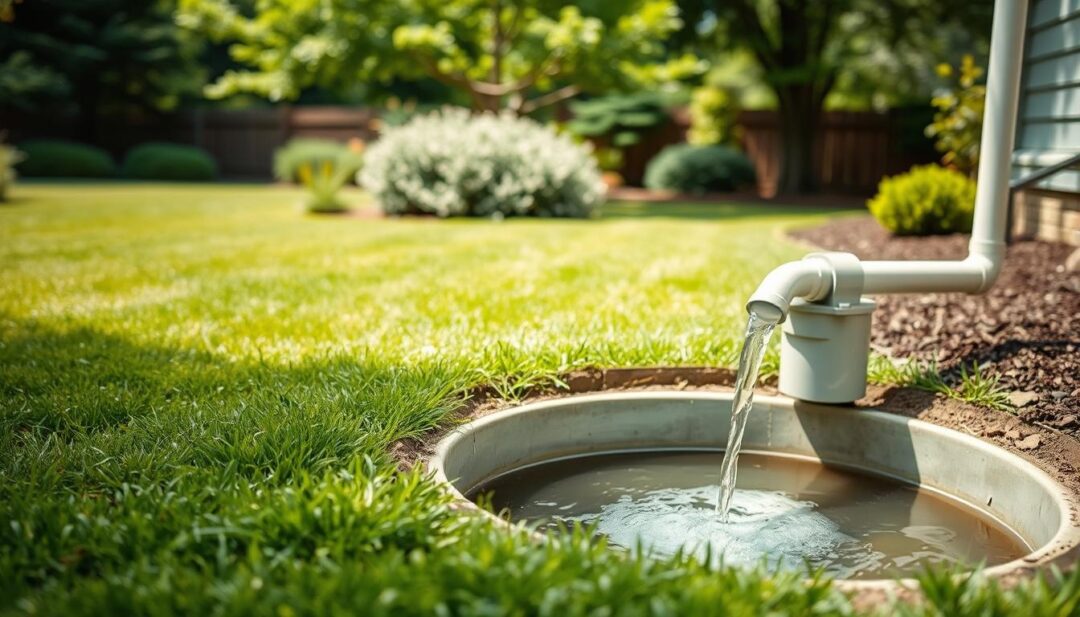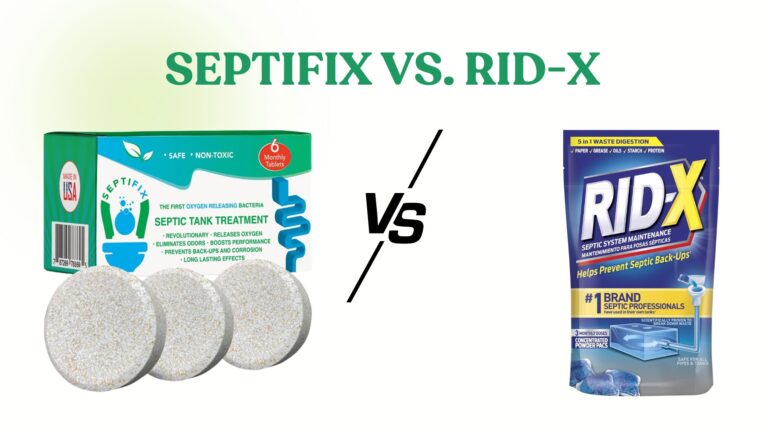Septic Tank Maintenance: Ensuring a Healthy System
Keeping your septic tank in good shape is crucial for homeowners with private sewage systems. If you ignore maintenance, you might face backups, expensive fixes, and harm to the environment. Regular care makes your septic system reliable for many years, saving you money and keeping your home’s value high. This guide will show you simple steps to keep your system running well.

If you’re new to septic systems or want to improve your care, this article has you covered. It talks about everything from daily habits to professional services. Simple actions like using less water and avoiding harsh chemicals are key. Learning these basics helps prevent emergencies and extends your system’s life.
Key Takeaways
- Regular maintenance prevents expensive repairs and system failures.
- Simple daily choices impact how long your septic system lasts.
- Ignoring care risks polluting local water supplies and violating environmental laws.
- Professional inspections and pumping are essential for long-term health.
- Proper septic tank maintenance boosts property value and resale potential.
Understanding Your Septic System
Every homeowner should know how their septic system works. This knowledge ensures it lasts a long time. We’ll cover its main parts and why septic system maintenance is crucial.
How Septic Systems Work
Septic systems handle waste through natural steps:
- Waste goes into the tank, where solids settle and liquids separate.
- Bacteria break down organic matter, preventing clogs.
- Treated liquid then exits into the drain field, where soil filters out contaminants.
Components of a Standard Septic System
| Component | Function |
|---|---|
| Sewer pipes | Carry wastewater from home to tank. |
| Main tank | Solid waste separates into scum, water, and sludge layers. |
| Drain field | Filters treated liquid before it re-enters groundwater. |
The Importance of Proper Maintenance
Ignoring septic tank care can lead to backups, expensive fixes, or harm to the environment. Regular maintenance:
- Prevents pipe blockages from built-up sludge.
- Can extend system life by 20-30 years with yearly checks.
- Ensures you follow local health rules.
The True Cost of Neglecting Septic Tank Care
Ignoring septic tank maintenance is a big mistake. It can hurt your wallet, health, and the environment. A failing system can lead to huge bills for repairs, cleanup, and property damage. Regular care is much cheaper than emergency fixes, but many homeowners don’t see its value.
A blocked drain might start at $200 to fix. But if ignored, it can cost $5,000 or more for repairs. Septic tank maintenance every 3–5 years costs about $250–$400. This prevents big problems.
Without regular care, backups can flood basements. This ruins belongings and costs a lot to fix.
- Health risks: Raw sewage leaks spread bacteria, threatening families and pets.
- Environmental harm: Contaminated groundwater harms local ecosystems and drinking supplies.
- Home value loss: Buyers avoid properties with unaddressed septic issues, slashing resale potential.
“Poor septic management causes 40% of reported water contamination cases in rural areas,” states the EPA. Timely septic tank care safeguards communities and pocketbooks.
Proactive steps now save money long-term. Compare small yearly investments in maintenance versus the chaos of ignoring red flags. Protect your home, health, and neighborhood—knowledgeable choices today prevent tomorrow’s disasters.
Essential Septic Tank Maintenance Tasks for Homeowners
Keeping your septic system in good shape is easy. Just do a little bit regularly. We’ll show you when to do each task, so you know exactly what to do and when.
Daily and Weekly Habits That Protect Your System
- Conserve water: Fix leaks and spread out laundry to avoid overloading the system.
- Don’t flush wipes, grease, or chemicals—they clog pipes and harm bacteria.
- Use enzyme-safe cleaners to help the septic tank maintenance process.
Monthly Monitoring Practices
Regular checks help catch problems early. Here’s a simple routine:
- Check if water drains fast. Slow drains might mean a clogged tank.
- Look for sewage smells—these could mean leaks or backups.
- Check pipes and lids for damage. Keep a record of what you find.
Seasonal Maintenance Checklist
Change your approach with the seasons:
- Winter: Insulate outdoor pipes. Clear snow from drain fields to prevent freezing.
- Summer: Use less water during parties. Keep trees away from the tank to avoid root damage.
- Fall: Clear leaves from drain fields to prevent clogs. Get a professional to check the system before holidays.
Following these steps makes upkeep simple. Small actions now prevent big problems later.
Signs Your Septic Tank Needs Immediate Attention
Knowing when your septic system is in trouble can save you thousands. Look for these urgent red flags:

- Strong sewage odors indoors or outside? This could mean a cracked tank requiring septic tank repair.
- Slow drains or gurgling pipes often signal a blockage needing professional septic tank service.
- Wet, spongy ground or lush green patches over your drain field? This points to a failing system needing urgent care.
- Visible sewage surfacing near your yard or toilets backing up? This is a septic tank repair emergency.
Don’t ignore these warnings! Minor issues like occasional gurgling might wait for routine service. But persistent backups or odors mean septic tank repair can’t wait. Waiting too long risks costly damage to your yard, home, and system lifespan.
Act fast: Contact a licensed professional immediately if you spot these signs. Early intervention with septic tank service prevents catastrophic failures. Protect your investment by addressing problems before they escalate—your wallet (and nose) will thank you.
Professional Septic Tank Pumping: When and Why
Regular septic tank pumping is key to keeping your system running well. Skipping it can lead to backups, clogs, and expensive fixes. Here’s how to plan, prepare, and budget for this important task.
Determining the Right Pumping Schedule
The frequency depends on how many people live in your home and the tank’s size. A home with four people and a 1,000-gallon tank might need service every 3–5 years. Keep an eye on:
- Number of residents
- Water usage patterns
- Age of the system
- Type of waste processed
What to Expect During Professional Pumping
Qualified septic tank service teams do the following:
- Check scum/liquid levels with cameras or rods
- Pump out solids and sludge from the tank
- Test flow rates and drainfield function
- Give a written report after service
Average Costs of Septic Tank Pumping
Prices usually range from $250–$500. Costs can go up for bigger tanks or hard-to-reach systems. Ask for:
- Written estimates
- Proof of licensing
- Disposal receipts showing waste removal
Sticking to this schedule helps avoid problems like pipe damage and system failure. Working with licensed pros also makes sure you follow local rules.
Septic Tank Treatments: Do They Really Work?
Choosing the right septic tank treatment can feel overwhelming. This section cuts through marketing claims to help you decide if treatments fit your septic tank maintenance plan.

Natural vs. Chemical Treatments
Compare approaches with this quick guide:
| Type | Pros | Cons |
|---|---|---|
| Natural | Biodegradable, eco-friendly | Slow results, inconsistent effectiveness |
| Chemical | Fast-acting, strong odor control | Potential to harm system bacteria |
Bacteria Additives: Friend or Foe?
Many additives claim to boost bacteria levels. Research shows:
- Properly functioning systems already host natural bacteria
- Overuse can disrupt pH balance
- Independent studies show minimal impact in well-maintained systems
Creating Your Treatment Plan
Follow these steps to decide:
- Assess your system’s health with a professional inspection
- Review maintenance history for clogs or backups
- Prioritize pumping and care over additives unless needed
Remember: Regular inspections and limited water use are more impactful than most treatments. Always pair treatments with good maintenance practices.
Common Septic Tank Problems and Solutions
Septic systems often face common problems. Ignoring these can lead to expensive repairs. Here’s how to spot and fix them early:
- Clogged Pipes
Symptoms: Slow drains, gurgling sounds. Cause: Grease or debris buildup. Fix: Use a plunger or baking soda/vinegar for minor clogs. Severe blockages need septic tank service from pros. - Drain Field Failure
Signs: Soggy yard, sewage odors. Cause: Overloaded or compacted soil. Solution: Stop water use, avoid driving over the area. A septic tank repair team can fix lines or install new drains. - Root Intrusion
Symptoms: Leaks, cracked tanks. Cause: Tree roots seeking moisture. Prevention: Trim trees, use chemical root killers. Severe damage needs a pro septic tank repair to seal cracks. - System Overload
Signs: Backed-up toilets, full tanks. Cause: Overuse or aging systems. Action: Reduce water use temporarily. Schedule regular septic tank service pumping to prevent overflow.
“A neighbor’s repeated backups stopped after they switched to quarterly inspections and installed a effluent filter.”
Most problems get better with quick action. DIY fixes work for small issues, but big or complex ones need experts. Regular checks and simple care can stop 80% of failures. Don’t wait to fix small leaks to avoid big septic tank repair costs.
The Importance of Regular Septic System Inspection
Keeping your septic system in top shape starts with regular septic system inspection. Just like you take your car in for a check-up every year, your septic system needs the same care. This helps catch problems early, saving you money and stress later on.
DIY Inspection Tips
Between professional visits, you can do some checks yourself:
- Check your drains for slow flow or gurgling sounds weekly.
- Look for wet spots or unusual plant growth near the tank in your yard.
- Use a flashlight to check cleanout pipes for blockages.
What Professional Inspectors Look For
A certified septic tank service technician looks at key areas:
- Pressure tests: Find cracks in the tank or drainfield.
- Camera inspections: Spot clogs or pipe damage without digging.
- Baffle checks: Make sure wastewater flows right, avoiding backups.
How Often Should You Schedule Professional Inspections?
| Factor | Recommended Schedule |
|---|---|
| System Age Over 15 years | Every 1–2 years |
| High Water Use (e.g., large households) | Annually |
| Local Regulations | Adhere to state guidelines (often 3–5 years) |
Pro tip: Schedule inspections with pumping to get a full system check. Always check local codes for the right schedule.
Extending the Life of Your Septic Tank
Proper septic tank care and regular septic tank maintenance are key to a long life. Simple actions like planting grass over the drain field and avoiding heavy machinery can prevent damage. Also, landscaping with shallow-rooted plants protects pipes without overloading the system.
- Install low-flow fixtures to cut water use by 30% or more.
- Balance laundry and shower schedules to avoid overwhelming the system.
- Use smart sensors to track flow rates and alert you to early issues.
“A well-maintained system can last 30+ years with proactive steps,” says the National Onsite Wastewater Recycling Association. “Small upgrades like water-efficient appliances pay off over time.”
Upgrading to dual-flush toilets or greywater systems reduces strain on the tank. While initial costs exist, these investments save on emergency repairs. Regular inspections every 3-5 years help catch issues before they escalate. By making these smart choices, you ensure your system runs smoothly for decades.
When to Call for Professional Septic Tank Repair
Knowing when to seek professional help is key to avoiding costly damage. If your system shows these red flags, contact a licensed technician right away:
Warning Signs That Require Expert Help
- Slow drains or gurgling sounds in multiple fixtures
- Visible backups in toilets or sinks
- Pooling water or soggy ground near the drain field
- Foul sewage odors indoors or outdoors
Finding Qualified Septic Tank Service Providers
Choose professionals certified by the National Onsite Wastewater Service Association (NOWRA). Verify licenses, insurance, and check reviews from past customers. Avoid companies that:
- Refuse to provide written estimates
- Pressure-sell unnecessary services
- Don’t offer emergency response options
Questions to Ask Before Hiring a Septic Professional
| Question | Why It Matters |
|---|---|
| Are you licensed and insured? | Protects against liability and ensures proper training |
| Do you offer both septic tank repair and cleaning services? | Ensures full-service capabilities for all system needs |
| What tools do you use for diagnostics? | Reveals investment in modern inspection technology |
Ask for references from previous septic tank repair projects and request detailed written estimates. Always confirm pricing upfront to avoid surprise costs.
Conclusion: Protecting Your Investment Through Proper Septic Tank Maintenance
A well-maintained septic system keeps your home safe from expensive repairs and environmental damage. Regular inspections and pumping are key. Start by making a yearly plan: pump every 3–5 years, track water use, and avoid harmful chemicals.
Small actions like watching what goes down drains and managing water use during holidays are crucial. Work with licensed pros for cleaning to keep your system running right. Remember, local rules and system age guide your maintenance plan. Get expert advice for your specific needs.
See septic tank care as a part of owning a home. Stay informed about your system’s needs and adjust as your family grows or the climate changes. With regular care, you’ll prevent problems and help keep waterways clean. Start protecting your investment today by taking control of your septic system’s future.
FAQ
How often should I schedule septic tank pumping?
Pump your septic tank every 3 to 5 years. This depends on your household size and how much you use it. Regular maintenance stops backups and saves money.
What signs indicate my septic tank needs immediate attention?
Look out for slow drains, gurgling pipes, strange smells, and green grass over the drain field. If you see these, call a septic service right away.
What does a septic system inspection entail?
A pro will check the tank’s structure, the drain field, and how well the system works. This is key for keeping your septic system in top shape.
Can I perform DIY maintenance on my septic system?
Yes, you can do simple checks and watch for bad smells. But for serious problems, it’s best to get a pro.
Are there treatments I can use to maintain my septic tank?
Yes, there are natural and chemical treatments. But make sure they won’t hurt the good bacteria in your tank. They help break down waste.
How can I extend the life of my septic tank?
Keep it maintained by pumping regularly, watching your water use, and avoiding harmful chemicals. Also, choose landscaping that won’t harm the drain field.
What are common septic tank problems and their solutions?
Issues like clogged pipes and tank damage are common. Regular maintenance and professional repairs can solve these problems.
How do I find a qualified septic tank service provider?
Look for licensed, insured pros with good reviews. Ask friends or search online for trusted septic services in your area.
What is the cost of septic tank pumping?
Pumping costs vary by location, tank size, and service. Expect to pay $200 to $500 on average for professional services.
Why is it important to maintain my septic system?
Keeping your septic system in check prevents expensive repairs, protects the environment, and keeps it running smoothly. It also helps keep your property value up.






